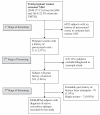Seizure occurrence, pregnancy outcome among women with active convulsive epilepsy: one year prospective study
- PMID: 25799895
- PMCID: PMC4386020
- DOI: 10.1016/j.seizure.2015.01.007
Seizure occurrence, pregnancy outcome among women with active convulsive epilepsy: one year prospective study
Abstract
Purpose: To determine the prevalence of active convulsive epilepsy, seizure frequency and the outcome of pregnancy amongst a cohort of pregnant women attending antenatal clinic (ANC) at two tertiary hospitals.
Methods: An observational cohort study conducted at the University of Maiduguri Teaching Hospital and State Specialist Hospital, Northeast Nigeria. Pregnant women attending antenatal care were screened for previous history of active convulsive epilepsy, and recruited consecutively according to a specified protocol. A standardized questionnaire was administered to record pregnancy history, nature of epilepsy and treatments received. They were followed-up during the course of the pregnancy based on the ANC schedule up to delivery. The outcome of pregnancies was recorded.
Results: A total of 7063 pregnant women were screened, of whom 103 (1.46%) subjects had at least a past history of seizure. Seventy-eight (1.10%) had a past history of seizure(s) from eclampsia and 23 (0.33%) pregnant subjects recruited were identified to have active convulsive epilepsy. The unadjusted prevalence of active convulsive epilepsy in pregnant women was found to be 3.33 per 1000 (95% CI: 2.1-4.8). Subjects who had a history of head injury and encephalitis were more likely to have seizures during pregnancy. (P=0.013 and P=0.041). Those who had recurrent seizures within the last six months before recruitment were more likely to have a negative pregnancy outcome (P=0.043).
Conclusion: Our study found a prevalence of active epilepsy of 3.33 per 1000 among pregnant women, with about one percent having a past history of seizure from eclampsia.
Keywords: Epilepsy; Outcome; Pregnancy; Seizure; Women.
Copyright © 2015 British Epilepsy Association. Published by Elsevier Ltd. All rights reserved.
References
-
- Fisher RS, Acevedo C, Arzimanoglou A, Bogacz A, Cross JH, Elger CE, et al. A practical clinical definition of epilepsy. ILAE official report. Epilepsia. 2014;55(4):475–82. - PubMed
-
- Beghi E. Comment on epileptic seizures and epilepsy: definitions proposed by the International League Against Epilepsy (ILAE) and the International Bureau for Epilepsy (IBE) Epilepsia. 2005;46(10):1698–702. - PubMed
-
- Sander JW. The epidemiology of epilepsy revisited. Curr Opin Neurobiol. 2003;16(2):165–70. - PubMed
-
- Beghi E, Hesdorffer D. Prevalence of epilepsy - an unknown quantity. Epilepsia. 2014;55(7):963–7. - PubMed
-
- Osuntokun BO, Adeuja AO, Schoenberg BS, Bademosi O, Nottidge VA, Olumide AO, et al. Neurological disorders in Nigerian Africans: a community-based study. Acta Neurol Scand. 1987;75(1):13–21. - PubMed
MeSH terms
Substances
Grants and funding
LinkOut - more resources
Full Text Sources
Other Literature Sources
Medical
Miscellaneous


